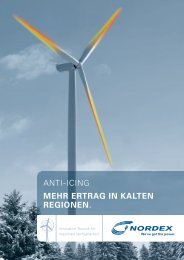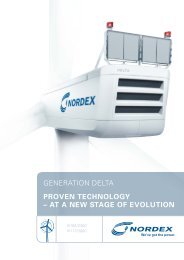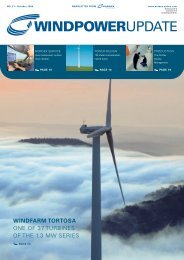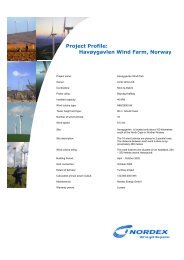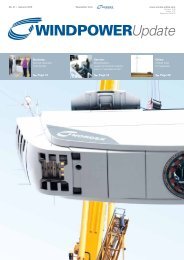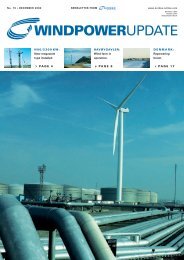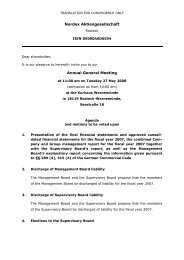OFFERING MEMORANDUM Global Offering of up to ... - Nordex
OFFERING MEMORANDUM Global Offering of up to ... - Nordex
OFFERING MEMORANDUM Global Offering of up to ... - Nordex
You also want an ePaper? Increase the reach of your titles
YUMPU automatically turns print PDFs into web optimized ePapers that Google loves.
Stall-regulated wind turbine Stall-regulated wind turbines have d ro<strong>to</strong>r blades bolted on<strong>to</strong> the<br />
d hub at a fixed angle. The geometry <strong>of</strong> the ro<strong>to</strong>r blade pr<strong>of</strong>ile has<br />
been aerodynamically designed <strong>to</strong> ensure that when the wind<br />
speed becomes <strong>to</strong>o high, it creates turbulence on the side <strong>of</strong> the<br />
ro<strong>to</strong>r blade which is not facing the wind. This d stalling prevents<br />
the lifting <strong>of</strong> the ro<strong>to</strong>r blade from acting on the ro<strong>to</strong>r.<br />
The basic advantage <strong>of</strong> stall regulation is that there is no need for<br />
moving parts in the ro<strong>to</strong>r itself, or a complex control system. On<br />
the other hand, stall regulation represents a very complex<br />
aerodynamic system which also presents many challenges with<br />
regard <strong>to</strong> the structural dynamics <strong>of</strong> the whole turbine, e.g.<br />
avoiding stall-induced vibrations. Stall regulation is more simple<br />
than pitch regulation and is therefore cheaper. Approximately two<br />
thirds <strong>of</strong> the wind turbines currently being installed worldwide are<br />
stall-regulated.<br />
S<strong>up</strong>ply management The Company’s organization and administration <strong>of</strong> s<strong>up</strong>ply and<br />
inven<strong>to</strong>ry management for turbine components.<br />
Turn out <strong>of</strong> the wind Turning the turbine so that the ro<strong>to</strong>r blades are no longer<br />
perpendicular <strong>to</strong> the wind direction. This is mainly used for<br />
maintenance work.<br />
Variable-speed wind turbine Variable speed turbines can be operated with variable ro<strong>to</strong>r speeds.<br />
This allows a better adjustment <strong>to</strong> the wind speed and increased<br />
exploitation <strong>of</strong> the kinetic energy <strong>of</strong> the wind (d asynchronous<br />
genera<strong>to</strong>r and d inverter).<br />
Volt (V) Unit <strong>of</strong> electric potential. 1,000 V = 1 kV<br />
Voltage peaks Voltage peaks occur when the rotation speed <strong>of</strong> a turbine is <strong>to</strong>o<br />
high. At nominal rotation speed and nominal output, the genera<strong>to</strong>r<br />
produces the nominal voltage. If the rotation speed is <strong>to</strong>o high,<br />
voltage peaks occur which can lead <strong>to</strong> faults.<br />
Wind energy The energy converted from the kinetic energy <strong>of</strong> the air.<br />
Wind farm Several wind turbines in the same place. This, in particular<br />
simplifies service.<br />
Wind regime A classification <strong>of</strong> locations according <strong>to</strong> strength <strong>of</strong> wind.<br />
A location where a certain wind strength is predominant will<br />
belong <strong>to</strong> the corresponding wind regime.<br />
G-5




